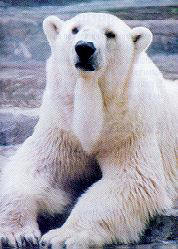|
|
|
|
|
 |
Learn about these fantastic
Arctic creatures that have
co-existed with
humans
for
30,000 years. |
|
The Inuit -the native peoples of the region- have a complex relationship
with Nanuk (their name for polar bears), their only
competitor for supremacy, who is both venerated and feared. For
them, Nanuk is their spiritual father and their ancestor. He
taught them
to hunt and how to
fish. When an Inuit kills a polar bear he will
observe a period of
mourning
to commemorate the death of a "member of his family".
Amongst the Haida people of
Queen Charlotte Island (Canada) a boy only becomes a man when he
has killed his first polar bear. On the other hand, if an Inuit
woman is
barren she will eat
the penis of a polar bear,
which is believed to restore fertility.
|
|
Polar Bear Facts |
|
* |
There are 20,000 polar bears left
in the
wild, all of them in the area around the Arctic
Circle. |
|
* |
Polar bears are the largest species of bear. They can weigh
up
to 680 kg. and can stand 3 m. tall.
Indeed, polar bears are the largest land carnivores in the
world. |
|
* |
Despite their size, polar bears have
comparatively small heads compared to other bears. Their
ears are also much smaller than those of their black and
brown cousins. The Inuit believe that Nanuk can hear
miraculously well, so they only talk about him with great
respect.
In fact, the
polar bear has
poor
hearing,
which it compensates for the powerful senses of smell and
vision. |
|
* |
With its excellent sense of smell a polar bear can
locate
a
seal which is 2 km.
away. |
|
* |
The polar bear has small eyes with special lenses, which filter the
bright sunlight reflected off the snow. |
|
* |
Polar bears are highly mobile animals. During its lifetime a polar bear
can cover an area of 250,000 km. These bears are also
excellent swimmers.
For instance,
they can swim a distance of 100 km. in about 10
hours. One polar bear was recorded as swimming 320
km. across open sea. On land a plar bear can run at 30
km./hour. |
|
* |
The skin of a polar bear is black like the skin of its closest
relative,
the grizzly. Over this the polar bear has two
coats of
fur.
The
inner coat is white
and soft. The hair of the outer coat is long and
hollow.
So far humans have been
unable to create a synthetic coat that
insulates
as well as the polar bear's. |
|
* |
The polar bear's
staple diet is seal
meal (and seal fat). However, if a polar bear can't find
seals it will eat
geese,
beached whales, small
rodents
and even
seaweed.
Norwegian researchers have recently discovered that polar
bears supplement their diets by occasionally killing
reindeer
in winter and spring. In summer polar bears will also eat
berries
and grass. |
|
* |
Recent research by Norwegian scientists from the Polar Institute in
Svalbard has found that female polar bears are growing
male
genitalia. The
evidence seems to suggest that the mutation is caused by
airborne
pollutants from Europe, specifically
polychlorinated biphenyls (PCBs). These substances damage
the bears' immune system and alter their hormone levels. |
|
* |
Polar bears are excellent hunters who kill their
prey
by hitting them with their front
paws
which function as
clubs.
When they are
stalking
seals polar bears have been known to cover their (black)
noses with their (white) paws so that the are less visible. |
|
|
Source: Think
in English |
|
GLOSSARY |
|
to
hunt:
catch and kill animals
(a cazar)
mourning: lamentation, ceremonial sadness (duelo, luto)
amongst: here "for" (para,
entre)
barren: infertile, sterile
(estéril)
in the wild: not in captivity (en
libertad)
up to: a maximum of (hasta)
despite their size: although they are very big
(a pesar de su tamaño)
in fact: however (sin embargo, en
realidad)
poor hearing: weak capacity to hear (audición baja)
to locate: find (ubicar, localizar)
seal: a marine
mammal that comes
on shore to breed (lobo marino)
for instance: for example (por
ejemplo)
relative: relation, related species (pariente, congener)
coats
of fur:
coverings of hair
(capas de pelo)
inner: inside (interior)
hollow: not solid in the centre (hueco)
so far: until now (hasta la fecha)
insulates: protects
something from the cold (aisle del frío) |
geese: gansos (singular: goose)
beached whales: whales
unable
to return to water
(ballenas varadas)
rodents:small gnawing animals having a single pair of
constantly growing incisor teeth
(roedores)
seaweed: algae (algas)
reindeer: Arctic deer (alces,
ciervos del Artico)
berries: a sort of wild fruit (frutos de bosque)
genitalia: masculine sexual organs,
genitals (genitales)
airborne pollutants: contaminating substances
carried by the wind (contaminantes arrastrados por el
viento)
prey
(uncountable noun): victims, animals that the polar bear hunts or catches for food (presas)
paws: foot of the bear (garras)
clubs: heavy stick used in conflict
(cachiporras)
stalking: moving secretly closer to a victim (acechando) |
|
|
|
|
 |
|
MAS "ECOLOGIA - VIDA SILVESTRE"
FORO
INICIO |
|